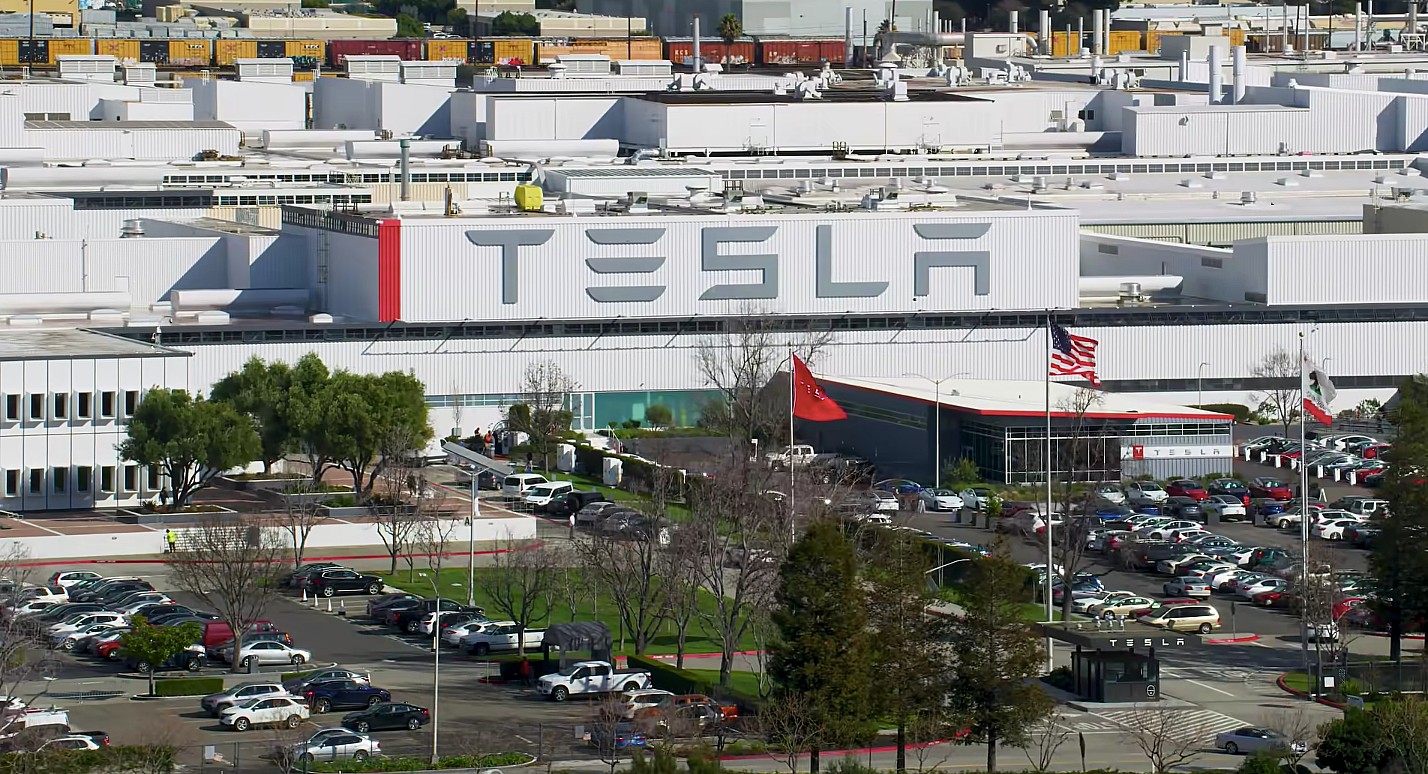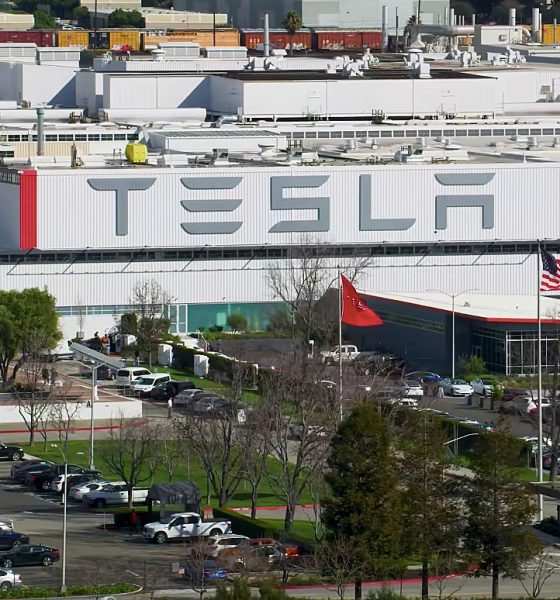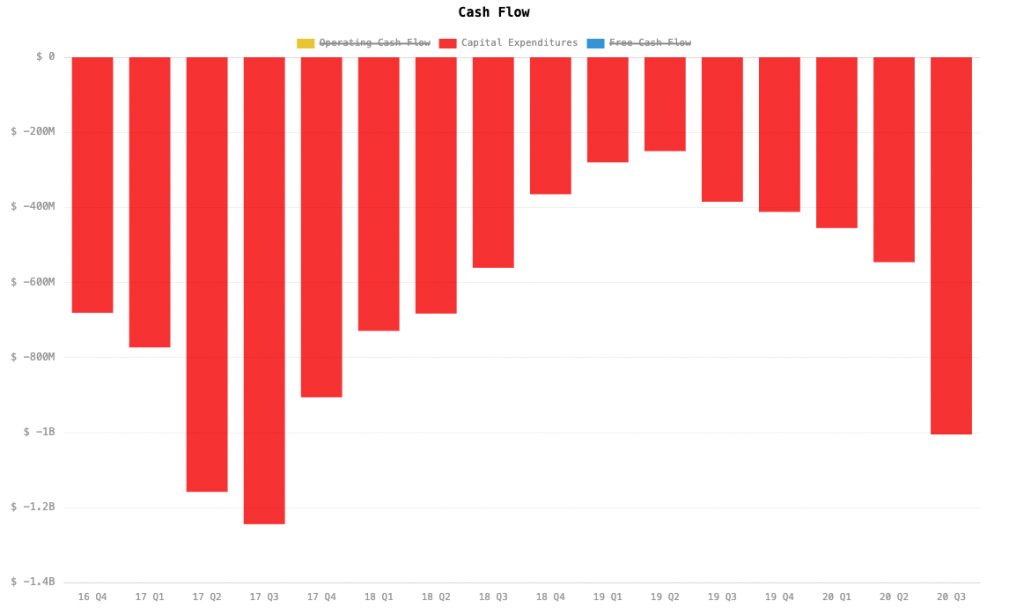

Investor's Corner
Tesla’s CAPEX efficiencies could pave the way for a fleet of ‘Alien Dreadnought’ factories
Tesla’s (NASDAQ:TSLA) Q3 10-Q Form for 2020 provided some interesting tidbits about the electric car maker’s plans for the coming years. Among these is the fact that the company is planning to increase its capital expenditures to about $4.5 to $6.0 billion in the next two fiscal years. These would be the highest expenditures that the company would be spending on its projects yet, with the amount rivaled only by 2017, when Tesla was dealing with the Model 3 ramp.
“Owing and subject to the foregoing as well as the pipeline of announced projects under development and all other continuing infrastructure growth, we currently expect our capital expenditures to be at the high end of our range of $2.5 to $3.5 billion in 2020 and increase to $4.5 to $6.0 billion in each of the next two fiscal years,” Tesla wrote.
While Tesla’s 10-Q Form noted that CAPEX will be higher than ever in the next couple of years, the company’s estimates still suggest that it has reached an incredible level of efficiency in terms of its expenses. It makes sense for Tesla’s CAPEX to be higher than it ever was, after all, since the company will be making more vehicles than ever before, and it would also be building factories in Berlin, Shanghai, and Texas. The company will be ramping its battery cell production capabilities as well.

As noted by Galileo Russell of YouTube’s Hyperchange channel, Tesla’s expectations for its CAPEX in 2021 and 2022 suggest that the electric car maker has become about five times more efficient on spending per unit of vehicle production compared to 2017. Interestingly enough, Elon Musk responded to the Tesla investor’s observations, lightly noting on Twitter that the company’s CAPEX efficiency back in 2017 was “trash.”
A look at Tesla’s capital expenditures over the years shows that Musk was telling the brutal truth. Back in 2017, Tesla’s CAPEX peaked at about $1.2 billion in one quarter as the company was launching the Model 3 in the Fremont Factory. Today, Tesla’s CAPEX has not broken this record, despite the electric car maker undergoing the Model Y ramp, the buildout of Gigafactory Shanghai, Giga Berlin, and Giga Texas, as well as an expansion of its battery production capabilities.
With this in mind, capital expenditures of $4.5 to $6.0 billion annually within the next two fiscal years seem to be a steal. This was mentioned by Russell on Twitter, and Musk responded by stating that the Tesla team has done excellent work over the years to make such progress possible.
What is rather remarkable is that Tesla is nowhere near done in the optimization of its operations. Over the years, and as the company attempts to hit its goal of producing millions of vehicles annually, there is a pretty good chance that Tesla would still improve and optimize its capital expenditures further. This would work in the company’s favor, especially as it attempts to build more factories and start the production of its upcoming electric vehicles like the Cybertruck, Semi, and the highly-anticipated $25,000 car.
If Tesla could accomplish these, the company would likely end up mastering the art of building electric car factories in a way that is frighteningly quick and capital-efficient, much like how it mastered the mass production of premium electric cars like the Model 3. This goes in line with Elon Musk’s statement back in July, when he noted on Twitter that the “Gigafactory is the product even more than the car.” The fact that every Tesla facility seems to be larger and more optimized than its predecessor highlights this idea.
During Battery Day, Elon Musk and Drew Baglino remarked that Tesla would need to produce an insane amount of batteries to achieve its goal of accelerating the advent of sustainable energy. This requires the company to build numerous factories at a rate that’s higher than ever before. With this in mind, there seems to be a good chance that Elon Musk’s “Alien Dreadnought” concept may see a resurgence in the near future. With a lineup of hyper-advanced factories that produce clean energy products at an optimal cost, after all, Tesla’s upcoming facilities may very well be considered as fleet of extraterrestrial machines that build machines.
Watch a discussion of Tesla’s CAPEX efficiency improvements in the video below.

Investor's Corner
Tesla gets price target bump, citing growing lead in self-driving

Tesla (NASDAQ: TSLA) stock received a price target update from Pierre Ferragu of Wall Street firm New Street Research, citing the company’s growing lead in self-driving and autonomy.
On Tuesday, Ferragu bumped his price target from $520 to $600, stating that the consensus from the Consumer Electronics Show in Las Vegas was that Tesla’s lead in autonomy has been sustained, is growing, and sits at a multiple-year lead over its competitors.
CES 2026 validates Tesla’s FSD strategy, but there’s a big lag for rivals: analyst
“The signal from Vegas is loud and clear,” the analyst writes. “The industry isn’t catching up to Tesla; it is actively validating Tesla’s strategy…just with a 12-year lag.”
The note shows that the company’s prowess in vehicle autonomy is being solidified by lagging competitors that claim to have the best method. The only problem is that Tesla’s Vision-based approach, which it adopted back in 2022 with the Model 3 and Model Y initially, has been proven to be more effective than competitors’ approach, which utilizes other technology, such as LiDAR and sensors.
Currently, Tesla shares are sitting at around $433, as the company’s stock price closed at $432.96 on Tuesday afternoon.
Ferragu’s consensus on Tesla shares echoes that of other Wall Street analysts who are bullish on the company’s stock and position within the AI, autonomy, and robotics sector.
Dan Ives of Wedbush wrote in a note in mid-December that he anticipates Tesla having a massive 2026, and could reach a $3 trillion valuation this year, especially with the “AI chapter” taking hold of the narrative at the company.
Ives also said that the big step in the right direction for Tesla will be initiating production of the Cybercab, as well as expanding on the Robotaxi program through the next 12 months:
“…as full-scale volume production begins with the autonomous and robotics roadmap…The company has started to test the all-important Cybercab in Austin over the past few weeks, which is an incremental step towards launching in 2026 with important volume production of Cybercabs starting in April/May, which remains the golden goose in unlocking TSLA’s AI valuation.”
Tesla analyst breaks down delivery report: ‘A step in the right direction’
Tesla has transitioned from an automaker to a full-fledged AI company, and its Robotaxi and Cybercab programs, fueled by the Full Self-Driving suite, are leading the charge moving forward. In 2026, there are major goals the company has outlined. The first is removing Safety Drivers from vehicles in Austin, Texas, one of the areas where it operates a ride-hailing service within the U.S.
Ultimately, Tesla will aim to launch a Level 5 autonomy suite to the public in the coming years.
Investor's Corner
Tesla Q4 delivery numbers are better than they initially look: analyst
The Deepwater Asset Management Managing Partner shared his thoughts in a post on his website.

Longtime Tesla analyst and Deepwater Asset Management Managing Partner Gene Munster has shared his insights on Tesla’s Q4 2025 deliveries. As per the analyst, Tesla’s numbers are actually better than they first appear.
Munster shared his thoughts in a post on his website.
Normalized December Deliveries
Munster noted that Tesla delivered 418k vehicles in the fourth quarter of 2025, slightly below Street expectations of 420k but above the whisper number of 415k. Tesla’s reported 16% year-over-year decline, compared to +7% in September, is largely distorted by the timing of the tax credit expiration, which pulled forward demand.
“Taking a step back, we believe September deliveries pulled forward approximately 55k units that would have otherwise occurred in December or March. For simplicity, we assume the entire pull-forward impacted the December quarter. Under this assumption, September growth would have been down ~5% absent the 55k pull-forward, a Deepwater estimate tied to the credit’s expiration.
“For December deliveries to have declined ~5% year over year would imply total deliveries of roughly 470k. Subtracting the 55k units pulled into September results in an implied December delivery figure of approximately 415k. The reported 418k suggests that, when normalizing for the tax credit timing, quarter-over-quarter growth has been consistently down ~5%. Importantly, this ~5% decline represents an improvement from the ~13% declines seen in both the March and June 2025 quarters.“
Tesla’s United States market share
Munster also estimated that Q4 as a whole might very well show a notable improvement in Tesla’s market share in the United States.
“Over the past couple of years, based on data from Cox Automotive, Tesla has been losing U.S. EV market share, declining to just under 50%. Based on data for October and November, Cox estimates that total U.S. EV sales were down approximately 35%, compared to Tesla’s just reported down 16% for the full quarter. For the first two months of the quarter, Cox reported Tesla market share of roughly a 65% share, up from under 50% in the September quarter.
“While this data excludes December, the quarter as a whole is likely to show a material improvement in Tesla’s U.S. EV market share.“
Elon Musk
Tesla analyst breaks down delivery report: ‘A step in the right direction’
“This will be viewed as better than feared deliveries and a step in the right direction for the Tesla story heading into 2026,” Ives wrote.

Tesla analyst Dan Ives of Wedbush released a new note on Friday morning just after the company released production and delivery figures for Q4 and the full year of 2025, stating that the numbers, while slightly underwhelming, are “better than feared” and as “a step in the right direction.”
Tesla reported production of 434,358 and deliveries of 418,227 for the fourth quarter, while 1,654,667 vehicles were produced and 1,636,129 cars were delivered for the full year.
Tesla releases Q4 and FY 2025 vehicle delivery and production report
Interestingly, the company posted its own consensus figures that were compiled from various firms on its website a few days ago, where expectations were set at 1,640,752 cars for the year. Tesla fell about 4,000 units short of that. One of the areas where Tesla excelled was energy deployments, which totaled 46.7 GWh for the year.
🚨 Wedbush’s Dan Ives has released a new note on Tesla $TSLA:
“Tesla announced its FY4Q25 delivery numbers this morning coming in at 418.2k vehicles slightly below the company’s consensus delivery estimate of 422.9k but much better than the whisper numbers of ~410k as the…
— TESLARATI (@Teslarati) January 2, 2026
In terms of vehicle deliveries, Ives writes that Tesla certainly has some things to work through if it wants to return to growth in that aspect, especially with the loss of the $7,500 tax credit in the U.S. and “continuous headwinds” for the company in Europe.
However, Ives also believes that, given the delivery numbers, which were on par with expectations, Tesla is positioned well for a strong 2026, especially with its AI focus, Robotaxi and Cybercab development, and energy:
“This will be viewed as better than feared deliveries and a step in the right direction for the Tesla story heading into 2026. We look forward to hearing more at the company’s 4Q25 call on January 28th. AI Valuation – The Focus Throughout 2026. We believe Tesla could reach a $2 trillion market cap over the coming year and, in a bull case scenario, $3 trillion by the end of 2026…as full-scale volume production begins with the autonomous and robotics roadmap…The company has started to test the all-important Cybercab in Austin over the past few weeks, which is an incremental step towards launching in 2026 with important volume production of Cybercabs starting in April/May, which remains the golden goose in unlocking TSLA’s AI valuation.”
It’s no secret that for the past several years, Tesla’s vehicle delivery numbers have been the main focus of investors and analysts have looked at them as an indicator of company health to a certain extent. The problem with that narrative in 2025 and 2026 is that Tesla is now focusing more on the deployment of Full Self-Driving, its Optimus project, AI development, and Cybercab.
While vehicle deliveries still hold importance, it is more crucial to note that Tesla’s overall environment as a business relies on much more than just how many cars are purchased. That metric, to a certain extent, is fading in importance in the grand scheme of things, but it will never totally disappear.
Ives and Wedbush maintained their $600 price target and an ‘Outperform’ rating on the stock.








